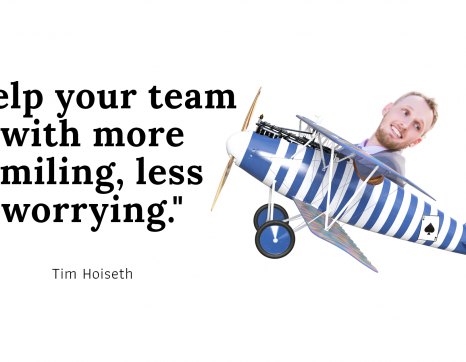
Corporate Team Building – New Buzzword?
Team building has become somewhat of a buzz word in corporate circles over the past few years. Many corporate event planners toss the term ‘corporate team building’ around willy-nilly as part of their marketing talk – but their events don’t always live up to the team building promise. For an event to actually transform and cement new ways of working together, it has to offer more than just lip service and a group trip to go fly-fishing.
Successful corporate team building events have a number of elements in common:
1. The opportunity to see the roadblocks to successful communication and teamwork
2. The chance to see co-workers in unfamiliar roles and situations
3. The necessity to work together toward a common goal
4. The support needed to forge productive new ways of working together
Good corporate event planners take those cut-and-dried concepts and turn them into a fun learning experience. The true geniuses in the corporate event world can create amazing and transforming events that will shake up your organization and wake up inspiration that you never knew existed in your company. Experienced planners of team building events know how to bring your coworkers and employees together in new ways that highlight the strengths you know they have, and show them how to use those strengths to build a solid service or production team that simply can’t be beat.
Teambuild, a norwegian company that specializes in corporate events and group tours, explains that team building challenges can be beneficial in highlighting how work obstacles are overcome by working together. Among the great teambuilding they offer is group tours in the norwegian wilderness, where cooperation to reach the goals is a must. Supervised by professionals.
Other companies plan ‘Service Days’ that may include building a children’s playground for charity or doing work for a local charity. In any case, the value of the day is in the lessons carried home at its end – that the team can overcome anything by getting to know each other and working together – as a team with unique members.

Tim has background as is business psychologist and work sociologist with expertise in building organisations and teams to solve problems for the future. Tim has expertise in technology and the symbiosis between human interaction and technology in operational processes.
Key metrics to measure in a team
6 Steps to Effective Communication.

Communication Smoothes the Path of Change
Productivity almost always suffers in times of great change, because employee stress dramatically increases due to the universal fear of the unknown. In these times, communication becomes more important than ever.
Often senior executives genuinely believe they are communicating with employees when it comes to matters that affect them. Unfortunately, they often underestimate the number of matters that includes, for the fact is that most high level decisions will affect employees in one way or another. (That’s why a new law recently went into effect in Britain forcing employers to answer employees’ questions on any changes or decisions that affect them.)
So how do you know what is important to employees and what to tell them? Well, you need to put yourself in the position, the mind, the heart of employeesóone employee at a time. If you were that person, what would you be worried about right now in the current situation? What would be important for you to know? What is the worst thing that could happen, and would you want to know about it in advance? How would you want to be told?
Of course, you can’t answer those questions yourself. You need input from the very people you are trying to understand. Depending on how much you can discuss or how much is already known, you might ask a few individuals what the grapevine is saying, and what people are worrying and wondering about.
Now, armed with this information, draft the answers to the questions. Of course they must be truthful answers, for insincerity is easily recognized and will deal a death blow to your communication efforts. Then they must be couched in terms that are clear and uncompromising, but also considerate and compassionate. It’s worth spending some time on this partólack of commitment to your message is also easily read and will automatically raise the cynicism level among employees.
Next comes dissemination of the information. There is, as we all know, no shortage of communication technology in the business world. However, the way a person receives news can dramatically affect how he or she feels about it, so you need to choose the medium very carefully. E-mail can be perceived as cold and unfeeling in many cases, although it is useful for routine updates that don’t have emotional overtones. Some messages are better spoken, either by managers to their groups or by the CEO to the whole organization.
If the messengers don’t have highly developed communication skills, it’s worth engaging the services of professional speech writers or presentation coaches to help them, but be sure the message remains honest, clear and compassionate.
And above all, follow through on your commitments and promises. Nothing turns employees off more than empty words, but sincere, caring, ongoing communication can form the basis for building employee engagement when the present time of turmoil ends.

Tim has background as is business psychologist and work sociologist with expertise in building organisations and teams to solve problems for the future. Tim has expertise in technology and the symbiosis between human interaction and technology in operational processes.
Key metrics to measure in a team
6 Steps to Effective Communication.

10 Ways That Communicate Our Attitude
The goal of successful marketing is to create long lasting relationships with your prospects by marketing your business with passion. When you’re not excited about what you’re doing, no one else will be either. Our passion for what we do in business is communicated through our attitude. Our attitude comes shining through in a variety of ways. How can you create an attitude that paves the way to success for you and your business?
1. You are what you speak. The words we use say everything about who we are and what we are about. Our spoken words are probably one of the most obvious ways we communicate our attitude to others. Think about what you say before you speak. Will it serve to build connection, community or relationship with others? If not, consider saying something else or even saying nothing. There’s a lot of wisdom in the words …”if you don’t have anything nice to say, don’t say anything at all.”
2. Dress for success. How you dress and the colors you wear communicate a lot about who you are. Find clothing that accents your best features. Make sure your clothes are properly tailored, neat, and wrinkle-free. If necessary, work with a personal shopper who can help you select apparel that is stylish and fits for the image that you wish to communicate. Consider how different colors look on you and how they make you feel. Wear clothes that you enjoy so you’ll come across in a more powerful way with potential customers or clients. While “clothes don’t make the man or woman”, they certainly speak volumes about what we think about ourselves and what we wish to project.
3. Be punctual. Thomas C. Haliburton said, “Punctuality is the soul of business.” Arriving on time for customer meetings, speaking engagements, meetings with vendors, or anything else you do in your business, shows that you respect others. Respect is the foundation for creating great long-term relationships with your clients. Showing up and on time is one of the best ways to show someone that you care about them. By keeping your commitments to others, you are acknowledging them and their needs. Caring about your customers must be your number one priority since it is through your relationships that you build your business. No one knows how much you care until you show them… by showing up.
4. Respond to contact several times each day. Nowadays, email is the most frequently used method of communication. Make it a goal to answer emails or your main forms of contact within eighthours. If you cannot answer emails during that timeframe, at least send back a reply that you have received the person’s email and that you will respond by a certain date and time. Never leave people wondering about whether you’ve received their email or not. If you don’t answer promptly, you are perceived as not being on top of things, that you aren’t detail oriented or, worse, that you don’t care about your customers. Don’t hesitate when it comes to communications. Set aside a couple times per day when you will concentrate solely on reading and replying to your email. Remember: This only goes for the important people in your business; partners, clients, potential clients etc. The rest can wait in line if you do not have time.
5. Return calls within hours. Time is of the essence when it comes to doing business. The difference between getting a new client can hinge on returning a phone call in a timely manner. You never know when you might be missing a time critical opportunity. A prompt response communicates an attitude that you value serving others and that you respect their time and their deadlines. In today’s competitive environment, if people don’t get the prompt attention they desire, it’s easy for them to seek out your competitor. Avoid missing opportunities to grow your business; plan two to three times each day to return calls.
6. Take responsibility. We communicate our attitude through the responsibilities we take upon ourselves. People can sense when we take full responsibility for our actions and the resulting outcomes. We communicate an aura of strength, confidence and leadership, which makes us even more attractive to the people with whom we do business. Think about how you can step up and take even more responsibility for your business and the results you achieve.
7. Take action. Successful business owners are people in action. They don’t wait for life to happen, they make life happen. Taking action communicates an attitude of excitement and accomplishment, which others find extremely attractive. Action tells others that you are a leader, that you move things forward, that you can make things happen, and most important, that you are confident doing what needs to be done. Just as people watch things that move, they watch people that move.
8. Body language. Along with the words that we speak, our bodies are probably the next most obvious way that we communicate our attitude to others. It’s as if we are walking billboards. Everything from your facial gestures to the way you sit and position your arms and legs, communicates volumes about who you are and your attitude towards others. Observe people who exhibit positive, open, and welcoming body language and try to emulate them. Read about body language and create a new way of being that represents what you most want to convey. One book I recommend is I Know What You’re Thinking by Dr. Lillian Glass.
9. Change your thinking; change your attitude. We all know that thoughts influence how we feel. They also influence the words we speak as well as our body language. Our thoughts become the filters through which we perceive the world. By changing our thoughts, we’ll automatically change our attitude. We wear our thoughts everywhere we go. Make sure you’re showing your best self at all times.
10. Smile. A smile is the universal sign of welcome and friendship. Nothing warms the heart of another, melts the tension of a situation, or endears people to us, than delivering a smile with sincerity. Practice smiling at everyone and everything. Incorporate it as a healthy habit. Not only does a smile affect others, it has an automatic effect on how you perceive everything around you. People are attracted to people who make them feel good. Start attracting people to you and your business by wearing a smile.

Tim has background as is business psychologist and work sociologist with expertise in building organisations and teams to solve problems for the future. Tim has expertise in technology and the symbiosis between human interaction and technology in operational processes.
Key metrics to measure in a team
6 Steps to Effective Communication.

Behavioral Interviewing – An introduction
Have you ever wondered, while interviewing a candidate, how will you suspend your own personal biases during the interview? Well, if you have, you might want to read on and learn how to do just that.
Behavioral interviewing is a relatively new mode of job interviewing. Behaviour and attitude at the workplace is increasingly important, and we see an increasing amount of companies also implementing standards for how to map this in an interview. Behaviour interviewing can be an effective tool, and because an increasing numbers of employers are using behavior-based methods to screen job candidates, understanding how to excel in this interview environment is becoming a crucial job-hunting skill.
What is Behavior Based Interviewing? Behavior-based interviewing focuses on your past experiences, behaviors, attitudes, personal skills and capacities that are job-related. It is based on the belief that past behavior and performance predicts future behavior and performance. You may use work experience, outsides activities, hobbies, volunteer work, school projects, family life as examples of your past behavior. However we suggest to focus on job related performance as much as possible. And to also remember that attitudes can be trained to some degree. Attitudes for the root of behaviour, so we do belive that people can change, keep that in mind.
Behavioral Interviewing Questions. This is the key to matching behavioral interviewing questions with specific soft sills or competencies. Below is a short list of 22 competencies with their definitions, suggestions for effective interviewing hints and a sample question for each.
1. Conflict Management: Addressing and resolving conflict constructively.
• Listen for proactive identification and resolution of concerns and issues.
• Sample question: “Describe the most difficult conflict you’ve ever had to manage.”
2. Employee Development/Coaching: Facilitating and supporting the professional growth of others.
• Listen for a belief in the potential of others and promoting of learning and development.
• Sample question: “Describe your personal experience with a mentor or coach.”
3. Interpersonal Skills: Effectively communicating, building rapport and relating well to all kinds of people.
• Listen for self-awareness, understanding and an ability to communicate effectively with others regardless of differences.
• Sample question: “Describe the most difficult working relationship you’ve had with an individual.”
4. Teamwork: Working effectively and productively with other.
• Listen for a strong commitment and contributions to team members working towards a specific goal.
• Sample question: “Give me an example of one of the most significant contributions you made as a member of a high performing team.”
5. Self-Management: Demonstrating self-control and an ability to manage time and priorities.
• Listen for composure, assertiveness and emotional stability.
• Sample question: “Give me an example of when you were able to meet the personal and professional demands in your life, yet still maintained a healthy balance.”
6. Empathy: Identifying with and caring about others.
• Listen for genuine caring, compassion and initiative in assisting others without expectations of rewards.
• Sample question: “Give me an example of when you identified with someone else’s difficulties at work.”
7. Planning/Organizing: Utilizing logical, systematic and orderly procedures to meet objectives.
• Listen for logical, organized and systematic approaches.
• Sample question: “ Describe the most complex assignment or project you’ve worked on.”
8. Customer Service: Anticipating, meeting and/or exceeding customer needs, wants and expectations.
• Listen for extraordinary efforts in responding to customer needs and wants to insure satisfaction.
• Sample question: “ Give me an example of when you went out of your way for a customer.”
9. Written Communication: Writing clearly, succinctly and understandably. Look for clear and understandable knowledge or written communication.
Sample question: “Give me an example of something you wrote for work that was effective in achieving a communication goal.”
10. Presenting: Speaking effectively to small and large groups.
• Listen for awareness, accuracy and composure.
• Sample question: “ Describe a situation when you had to give a presentation to a group of people you have never met.”
11. Persuasion: Convincing others to change the way they think, believe or behave.
• Listen for persistence, determination and a “never-give-up” attitude in efforts to meet goals.
• Sample question: “Describe a situation where you were able to convince others to your way of thinking.”
12. Goal Orientation: Energetically focusing efforts on meeting a goal, mission or objective.
• Listen for the ability to maintain their direction in spite of obstacles in their path.
• Sample question: “Give me an example of the most significant professional goal you have met.”
13. Flexibility: Agility in adapting to change.
• Listen for a positive attitude towards lots of activity, multi-tasking and change, in general.
• Sample question: “Give me an example of when you were forced to change priorities or direction.”
14. Continuous Learning: Taking initiative in learning and implementing new concepts, technologies and/or methods.
• Listen for a positive attitude towards self-improvement, learning and the application of knowledge.
• Sample question: “How do you keep current on what’s going on in your field?”
15. Personal Effectiveness: Demonstrating initiative, self-confidence, resiliency and a willingness to take responsibility for personal actions.
• Listen for a strong sense of self, personal responsibility, courage and resilience.
• Sample question: “What do you think has enabled you to meet your goals?”
16. Problem Solving: Anticipating, analyzing, diagnosing and resolving problems.
• Listen for an analytical and disciplined approach to solving problems.
• Sample question: “Describe a situation when you anticipated a problem.”
17. Negotiation: Facilitating agreements between two or more parties.
• Listen for seasoned expertise in negotiating “win-win” agreements.
• Sample question: “Give me an example of when you were able to facilitate a “win-win” agreement between two or more adversarial parties.”
18. Management: Achieving extraordinary results through effective management of resources, systems and processes.
• Listen for shrewd business sense, understanding of operational issues and an ability to improve the bottom line.
• Sample question: “Describe the largest budget you’ve ever developed and had responsibility for managing.”
19. Leadership: Achieving extraordinary business results through people.
• Listen for an ability to obtain the trust, commitment and motivation of others to achieve goals and objectives.
• Sample question: “If you have held a leadership position in the past, draw the organizational chart above and below your position to illustrate the scope of your leadership responsibilities.”
20. Decision Making: Utilizing effective processes to make decisions.
• Listen for an ability to make timely decisions under difficult circumstances.
• Sample question: “Give me an example of when you had to make a quick decision when the risk of making an error was high.”
21. Futuristic Thinking: Imagining, envisioning, projecting and/or predicting what has not yet been realized.
• Listen for optimism, predictions and a commitment to future possibilities.
• Sample question: “Describe a situation when you were correct in seeing a future trend that others didn’t.”
22. Creativity/Innovation: Adapting traditional or devising new approaches, concepts, methods, models, designs, processes, technologies, and/or systems.
• Listen for “out-of-the-box” thinking and unusual approaches.
• Sample question: “ Describe a work situation when you adapted a concept, design, process or system to meet a need.”
Be sure to probe for as many details and specifics as possible such as names, dates and other verifiable information. Skilled interviewers will also ask candidates for their thoughts or feelings about a situation to gain further insight.
How Can I Prepare for A Behavioral Interview?
• Be familiar with the type of positions for which you’re applying. • Reflect on your own background. What skills do you have that relate to the job you are applying for?• Think of examples from your past experience where you demonstrated those skills. How can you give an example about your use of particular skills or knowledge? • Be prepared to provide examples of when results didn’t turn out as you planned. What did you do then? In hindsight, what would you do differently?• Identify two or three of your strengths and determine how you will convey these assets during the interview.• Once you land your desired position, keep a personal achievement diary to help document demonstrated performance.
How Do I Prepare For a Behavioral Interview If I Am The Interviewer or Company Hiring?
• If the job could talk; what would it say? About:- The behaviors of the person who will always be able to deliver superior performance?- The attitudes of the people doing the job?- The attributes or soft skills needed for superior performance?
• Job Benchmarking with a system such as Trimetrix, reveals why, how and what an individual can contribute to a job.
• It identifies a complete hierarchy of competencies or personal skills. It allows you to clarify any position issues. It prioritizes and validates the competencies required.
• This can be done for any:- Leadership/Management Exempt position- Professional Exempt position- Hourly non-exempt position
• Anytime you need an unbiased opinion about whether someone is right or wrong for the job, the computer will analyze the input of up to ten respondents to identify the importance of the 23 soft skills competencies.
• Where can you do this…through the Internet! Have up to ten respondents identify the importance of the 23 soft skills competencies and then see how your candidate matches up.
The premise behind behavioral interviewing is that the most accurate predictor of future performance is past performance in similar situations. Behavioral interviewing, in fact, is said to be 55 percent predictive of future on-the-job behavior, while traditional interviewing is only ten percent predictive.
Good luck with the process of Behavioral Interviewing and hope the concepts encourages you to use the Behavioral Interviewing questions provided in this article to get you started.

Tim has background as is business psychologist and work sociologist with expertise in building organisations and teams to solve problems for the future. Tim has expertise in technology and the symbiosis between human interaction and technology in operational processes.
Key metrics to measure in a team
6 Steps to Effective Communication.

Work Life Balance And The Power of Positive Thinking
Can we learn how to respond optimistically and hopefully to events that challenge work life balance? According to psychologist and researcher Martin Seligman, the answer is YES. While some folks appear to be hardwired to respond optimistically to ups and downs in life and work, others are wired for pessimistic responses. Fortunately, you do not have to settle for the wiring you were born with. Find out how you can improve your resilience and hopefulness by acquiring positive thinking skills. Belive it or not, it will have an effect on your co-workers how you reach to things.
I like to think of the process of building hopefulness, resilience and positive thinking skills as an analogue to building physical fitness: it takes attention, concentration, commitment, and repetition. If you approach a workout program with those qualities, you can almost always improve your fitness.
The first hurdle to get over is the belief that you already need to be different in order to succeed. You don’t. You are the way you are and you can start from here, overwhelmed, worried, anxious, whatever. Don’t fall into your story about how you feel, but take a stand for what you intend to accomplish to restore your work life balance and where you plan to go. You do not need to feel better before you try these practices — do them now. Another caveat: Do not interpret your progress in the short term — measuring increase in strength and endurance after a single workout would be silly.
Seligman points out that people with an optimistic approach to life habitually accept positive thoughts and dispute negative thoughts. Those of us who are wired to be more pessimistic tend to dispute the positive and accept the negative. Optimists tend to assume that their life balance will be restored, good events will happen again and that bad events are an exception; pessimists assume the reverse. I am oversimplifying his rigorously considered arguments, and I encourage you to read the book if the science of this is important to you.
Here’s a practice he recommends for shifting from hopelessness to hopefulness. I successfully use it with my clients to help them restore their work life balance. He calls it ABCDE for:
Adversity — Beliefs — Consequences — Disputation — Energization.
A – Adversity: Start by spelling out the nature of the situation. Notice that you can experience hopelessness in response to ostensibly positive situations as well as to negative ones. For example, getting a new client or being accepted into a final round of interviews can upset your balance and send you into a whirlwind of anxiety and fear that produces just as much hopelessness and overwhelm as not getting the job or not making the cut.
B — Beliefs: This is your opportunity to spell out the thoughts and beliefs that are fueling the negative response.
C — Consequences: Look at the consequences of your beliefs — what happened as a result? How do you behave? What happened then?
D — Disputation: Actively dispute the beliefs that break your life balance and send you into the downward spiral. This is where you practice arguing with yourself in a productive way.
E — Energization: When you have been effective in disputing the problem beliefs, you feel an influx of energy, a sense of renewed hope, or at least of peacefulness.
So, here’s an example on how to handle a situation:
Adversity: Edward was excited about moving forward on two projects when he fell on his bike and cracked his ribs. He was okay and working hard with this for almost three days, then depression and anxiety set in and his usual positive thinking ability left him. Instead of feeling like moving forward he felt like bursting into tears.
Beliefs: How will he ever restore his work life balance and get things done if he can’t stop these mood swings? Maybe he is just not meant to lead these projects, he was thinking. He don’t know enough and he can’t seem to get started — he probably should have said no in the first place. It would be better to bow out now, as embarrassing as that will be, than to keep going and have a bigger train wreck later when I just can’t make the grade.
Consequences: These beliefs leave him feeling very sad and small, like a six year old he thinks, and then suddenly he wonders how a six year old can possibly be a leader. Brian find it hard to concentrate and just want to hide.
Disputation: Constant low-grade pain can take it out of anyone. The world is not going to come to an end if you delay things because you’ve been injured. And who says you have to do it alone anyway? Some of the problem is that you don’t have enough information to go forward. That calls for making requests of others, not for blaming yourself. And when you’re not leaning on yourself so hard, your positive thinking ability starts coming back and your mood lightens — so maybe it would be smart to cut yourself some slack this week after letting folks know what is going on. You don’t have to crawl under a rock — you can reach out instead to restore your work life balance. And even if some work projects end up being passed on to others, there will always be other opportunities.
Energization: Brian called and emailed colleagues to regroup. Not only did these conversations relieve his anxiety, they made simple next steps quite clear. In one case, my summary of a conversation ended up being exactly what our group needed to move forward. Who knew? Brian had been worried about making things happen on his own when all along his strength was in articulating and clarifying complex input from many sources.
See how this works? I do strongly recommend implementing a positive way of thinking in your work life. If you struggle with hopelessness and challenge yourself to work through this one exercise on a regular basis (and if that means five or ten times a day, so be it), your positive thinking skills will grow and you WILL get relief. Remember — don’t measure change before it can happen — keep doing the practices long enough for significant positive shifts to take root and grow.

Tim has background as is business psychologist and work sociologist with expertise in building organisations and teams to solve problems for the future. Tim has expertise in technology and the symbiosis between human interaction and technology in operational processes.
Key metrics to measure in a team
6 Steps to Effective Communication.

Public speaking: 5 Tips to improve your Public Speaking
Among a number of fears possessed by the people today, public speaking tops the list. Having to talk about something in front of a huge number of people where everyone has their focus on you can make you a bit shaky and nervous. This is a general problem with a majority of the people. But, in today’s world if you want the people to know what you are up to, you have to practice speaking in front of the public. Look around and see you can recall the name of the people who made it big in their own field by recalling what they spoke. Therefore, you can see that how much speaking in front of the public is important.
In order to improve your communication skill when you are standing in the middle of a huge crowd of people and giving out lectures, you need to follow 5 basic tips for improving your oratory skills:
5 tips:
1) Do a lot of Homework
This essentially means practicing in private so that you can perform better in front of the people. Practice in front of the mirror as if you are talking to someone, practice in front of your closest friend who will rectify you without being too critical. Practice well so that you can get the entire subject matter by heart. In that case you won’t have to make up a story when you are up on the dais. “Practice makes a man perfect” as the popular proverb goes, repeatedly rehearsing will make you a perfectionist in the speech you will be delivering and if you prepare well, then you are bound to enthral the audience with your speech.
2) Be a good listener
One of the astounding element that can make you am exceptional speaker is listening. Listen to how other people say, how they communicate their message. Listen to what your audience say or want you to answer. The more actively you listen to what other say, the more you will be able to be a good speaker. It is true, that not everyone holds a rich opinion, but somehow you will be getting a clue out of them which can make you prepare well for your forthcoming speech.
3) Record and Watch
Do a video recording of your speech instead of taking a selfie. Then play the video a number of times to pinpoint what are the basic flaws you are having while you are talking. This is a bit painful, but nonetheless important, as this will help you in self-evaluation. You will be able to rectify your speech. You will see using a lot of extra and unnecessary vocabularies like, “ok, just, umm, like” and many more. These words hinder you from delivering the exact message in a clear way. Repeated recording and watching your own videos will help a lot in improving your diction and speech.
4) Honesty
Be honest when it comes to improving yourself. There is no better way than to being honest to yourself and think of putting your best efforts to reach the zenith. Nobody is telling you to be the unbeaten champion in public speaking, but you should be able to convey your message clearly without a fail. And while doing this, honesty is something you need to possess.
5) Get a hold of your subject and audience
When you are making a speech on something, you should do a good homework to know the topic you are dealing with. For example, if you are delivering a speech on the retail or food industry, you must know every detail of the industry. Another thing you must consider is knowing your audience. You must know whom you will be talking to. Make presentations by keeping that in mind. Keep such substances in your subject which will evoke responses from your audiences.
In addition to the above points, another point can be added to this. There is no harm in carrying the notes you prepared for your speech. In case you lose out some points or can’t remember what you were to tell, you can keep the notes handy and have a look at them. Don’t worry, your audience won’t react to that.
By following the above points, you can surely aim to become a professional speaker.

Tim has background as is business psychologist and work sociologist with expertise in building organisations and teams to solve problems for the future. Tim has expertise in technology and the symbiosis between human interaction and technology in operational processes.








